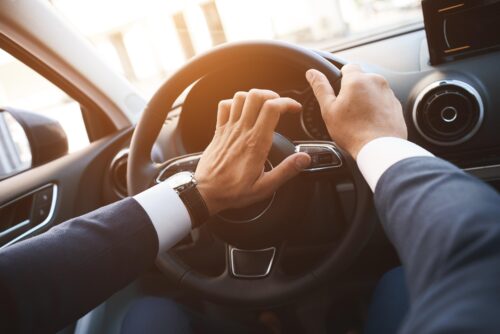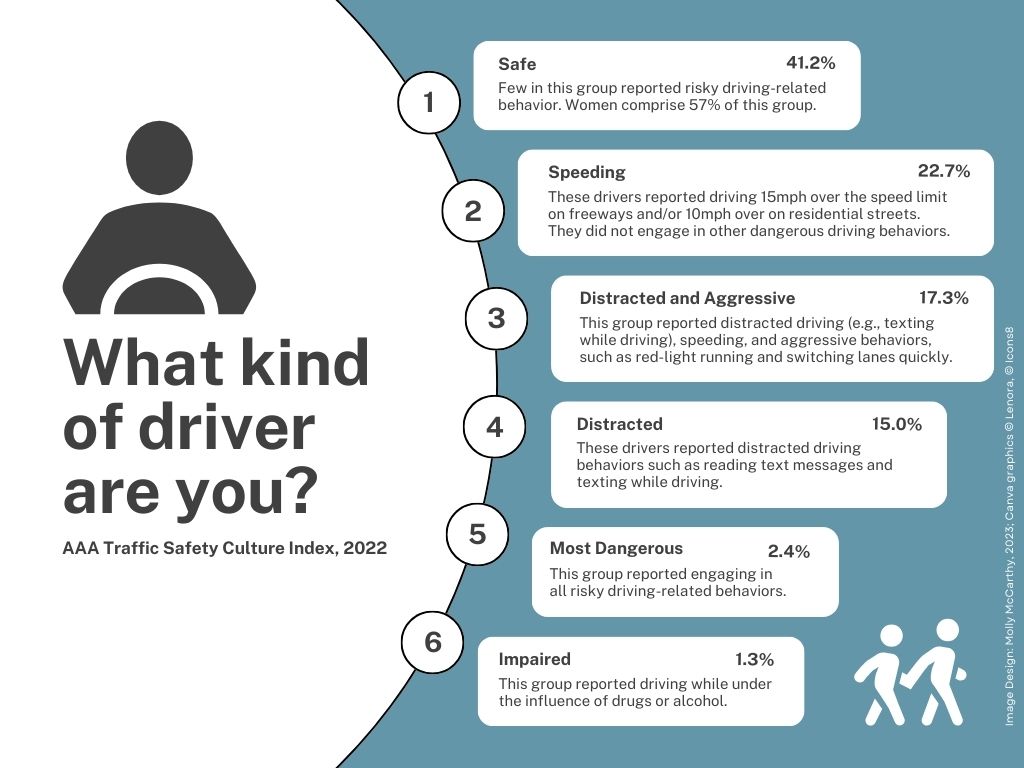
The Six Driver Profiles
What kind of driver are you? The AAA Foundation for Traffic Safety released its latest Traffic Safety Culture Index survey (TSCI). For the first time in the report’s 10-year history, six driver profiles were determined after AAA researchers analyzed self-reported risky driving behaviors by the participants – about 2,500 licensed U.S. drivers over the age of 16.
Based on participant feedback, the AAA research team profiled six types of drivers who populate our roads: Safe, Speeding, Distracted and Aggressive, Distracted, Most Dangerous, and Impaired (classified by highest to lowest percentage).
Safe
The good news is that four in 10 self-reported as safe drivers. “Reassuringly, the largest group of drivers in our sample – 41 percent of them we’re calling safe drivers – didn’t report engaging in any of the dangerous behaviors that we looked at in the last 30 days,” said Dr. Rebecca Steinbach, Senior Researcher from the AAA Foundation for Traffic Safety, during her appearance on AutoVision News Radio.
The bad news is that more than half (59 percent) of the respondents reported engaging in dangerous behavior.
Speeding
About 23 percent were profiled in this category. These were drivers who reported speeding on the freeways or residential roads in the last 30 days but tended not to report any of the other behaviors like distracted or impaired driving.
Distracted & Aggressive
In the TSCI study, 17 percent were categorized as distracted and aggressive drivers. These were drivers who reported distracted driving and aggressive activities behind the wheel. They described reading text messages or talking on cell phones while driving.
They also disclosed speeding on residential roads or freeways and other aggressive driving moves, such as running a red light when they could have stopped safely or following vehicles closely behind and switching lanes erratically.
Distracted
Participants in this category totaled 15 percent and reported doing things like sending or reading a text message while driving in the last 30 days. They exhibited similar unsafe behaviors behind the wheel as the prior group, minus the aggression.
Most Dangerous
About 2.5 percent were listed in the most dangerous category. This group engaged in all the bad behaviors the AAA research team considered. They reported speeding, not wearing their seatbelts, distracted and aggressive driving, and operating while impaired.
Impaired
On its own as a driver profile, impairment had the lowest percentage.
“Impaired drivers made up about one percent of our sample, and it was our smallest group,” Dr. Steinbach said. “These were drivers that admitted impaired driving, driving under the influence of alcohol or cannabis or other prescription drugs but tended not to report any of the other behaviors.”

Speeding Seems Socially Acceptable
In addition to profiling the six kinds of drivers who populate our roads, which was provided as a supplement to the traditional TSCI annual report, the AAA Foundation for Traffic Safety tracked the perceptions of and attitudes towards dangerous driving behaviors.
One of the confounding issues uncovered in the research was that, compared to previous TSCI surveys, fewer drivers perceived speeding as dangerous. In addition, speeding behaviors had the lowest perceived social disapproval of all the examined unsafe driving behaviors. Further, according to Dr. Steinbach, measures to curb speeding, like automatic speed cameras, had the lowest levels of support of any of the countermeasures the research team asked about.
In the meantime, speeding took a lead position in the study as a behavior that, if effectively addressed, could make the biggest impact on improving road safety. AAA researchers contended that greater enforcement of speeding laws and targeted interventions could simultaneously deter other risky behaviors.
“This study highlights a near-term and important opportunity to concentrate on enforcement that makes an immediate safety impact,” said Jake Nelson, AAA’s Director of Traffic Safety Advocacy. “Focusing on speeding drivers will deter other risky driving behaviors like impaired driving and red-light running. This traffic safety measure will have the greatest impact on safety.”
Perceived Dangers of Texting & Drowsy Driving
Unlike speeding, most (93 percent) of the TSCI survey respondents viewed texting, emailing, or reading content on handheld devices while driving as very or extremely dangerous. By contrast, fewer (76 percent) thought holding or talking on a smartphone was very or extremely dangerous. Interestingly, although most (87 to 95 percent) said their loved ones would disapprove of these behaviors, more than 25 percent said they do some or all of these things anyway (e.g., sending emails or texting).
“Using a cell phone stimulates the portion of a person’s brain that releases a chemical called dopamine,” explained Jim Flegel, Special First Lieutenant and Traffic Safety Specialist with the Michigan State Police. “This makes it difficult to resist the urge to respond immediately to a text or social media notification, regardless if the person is operating a vehicle.”
Only 20 percent felt hands-free use of cell phones was very or extremely dangerous, which may be why most (59 percent) indicated they used hands-free technology to talk, text, or email while driving in the last 30 days. There was a lot of support (84 percent) for laws against holding devices while driving, and a surprisingly high number (42 percent) supported banning hands-free technologies to read, text, or email while driving.
Most respondents believed driving through a red light (83 percent) or forcefully switching lanes and following closely behind other vehicles (89 percent) is very or extremely dangerous.
I recently interviewed researchers at the University of Iowa to learn about the impact of drowsy driving. I was curious to hear how the TSCI respondents felt about it. After AAA researchers compiled the data, 95 percent perceived drowsy driving as very or extremely dangerous. However, only 18 percent reported driving drowsy in the past 30 days.

The Big Question
The million-dollar question is, even though we readily acknowledge that behavior like speeding or aggressive driving is dangerous, why do we still do it? The latest TSCI survey from AAA did not approach this question directly, but I’m sure we could each come up with a few ideas – whether it’s a case of bad habits or because driving is such a routine task, and we take it for granted.
“Cars are awesome machines, but with great power comes great responsibility,” said Dr. Steinbach, referencing Uncle Ben’s frequently dispensed advice to young Peter Parker. “Maybe when we’re operating a machine, it’s not the best time to be multitasking or trying to make up time in our busy day. We’ve become so used to it that we forget about the risk that we can pose to others, particularly people who are not protected by vehicles, like pedestrians.”
“Unfortunately, I do not have an explanation of why drivers would participate in risky driving behavior,” Flegel added. “However, we do know that it only takes being distracted for a brief moment, and a tragedy can occur.”
As traffic safety concerns have escalated, insights from this latest TSCI survey shed light on public perceptions, attitudes, and engagement in unsafe driving behaviors, offering valuable guidance for developing effective countermeasures. The findings help researchers, practitioners, and safety advocates understand drivers’ beliefs to identify relevant issues and formulate corresponding strategies to help reduce dangerous driving and improve road safety.
“Despite acknowledging the dangers, some drivers continue to engage in potentially deadly behaviors, particularly speeding,” said Dr. David Yang, President and Executive Director of the AAA Foundation for Traffic Safety. “Understanding the different types of risky driving behaviors and the characteristics of drivers who engage in them is crucial for developing targeted interventions to achieve safe mobility.”


